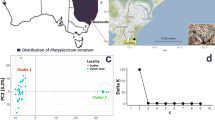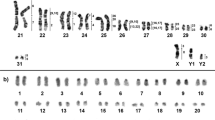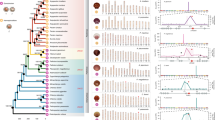Summary
Sex-associated and floating translocation complexes are characteristic of dioecious species of Viscum, but are virtually absent in monoecious species. In most of the dioecious species, fixed sex-associated translocation complexes are present, with the male being the heterozygous sex. The sex-associated multivalent is usually ⊙4 (ring-of-four) or ⊙6, rarely ⊙8. In only a few of the dioecious species are sex-associated translocations not apparent. Most of the dioecious species are also polymorphic for floating translocations, producing one or more additional multivalents ranging from ⊙4 to ⊙12. Floating translocations may be more frequent in species which do not have sex-associated translocations. Supernumerary chromosomes are also present in several species. Sex ratios are at unity in most dioecious species, but female-biased ratios as low as 0·52 and male-biased ratios as high as 1·40 may occur in some species. The high correlation between dioecy and translocation heterozygosity suggests that translocations are primarily associated with the origin and establishment of dioecy, and any role they play in the maintenance of biased sex ratios through meiotic drive is probably secondary. A model is presented in which male- and female-determining factors are non-allelic, and sex-associated translocations serve to stabilise dioecy by bringing the sex factors into linkage. Subsequent structural rearrangements within a sex-associated translocation complex may bring the sex factors together in one chromosome pair, releasing floating translocations. The high frequencies of floating translocation heterozygosity in some species indicate that such heterozygosity has adaptive value.
Similar content being viewed by others
Article PDF
References
Audus, L J. 1972. Plant Growth Substances. Leonard Hill, London.
Baker, H G. 1967. Support for Baker's Law—as a rule. Evolution, 21, 853–856.
Barlow, B A, and Wiens, D. 1975. Permanent translocation heterozygosity in Viscum hildebrandtii Engl, and V. engleri Tiegh. (Viscaceae). Chromosoma (Berl), 53, 265–272.
Barlow, B A, and Wiens, D. 1976. Translocation heterozygosity and sex ratio in Viscum fischeri. Heredity, 37, 27–40.
Barlow, B A, Wiens, D, Wiens, C, Busby, W H, and Brighton, C. 1978. Permanent translocation heterozygosity in Viscum album and V. cruciatum: sex association, balanced lethals, sex ratios. Heredity, 40, 33–38.
Bawa, K S, and Opler, P A. 1975. Dioecism in tropical forest trees. Evolution, 29, 167–179.
Bloom, W L. 1977. Translocation heterozygosity, genetic heterozygosity, and inbreeding in Clarkia speciosa. Evolution, 31, 256–264.
Bose, T K, and Nitsch, J P. 1970. Chemical alteration of sex expression in Luffa acutangula. Physiologia Pl, 1206–1211.
Charlesworth, B, and Charlesworth, D. 1979. A model for the evolution of dioecy and gynodioecy. Amer Nat (in press).
Danser, B. 1941. The British-Indian species of Viscum revised and compared with those of South-Eastern Asia, Malaysia, and Australia. Blumea, 4, 261–319.
John, B. 1976. Population Cytogenetics. Edward Arnold, London.
Mechelke, F. 1976. Sex-correlated complex heterozygosity in Viscum album L. Naturw, 8, 390.
Muller, H J. 1925. Why polyploidy is rarer in animals than plants. Amer Nat, 59, 346–353.
Ross, M D, and Weir, B S. 1976. Maintenance of males and females in hermaphrodite populations and the evolution of dioecy. Evolution, 30, 425–441.
Westergaard, M. 1958. The mechanism of sex determination in dioecious flowering plants. Adv Genet, 9, 217–282.
Wiens, D. 1975. Chromosome numbers in African and Madagascan Loranthaceae and Viscaceae. Bot J Linnean Soc, 71, 295–310.
Wiens, D, and Barlow, B A. 1973. Unusual translocation heterozygosity in an East African mistletoe (Viscumfischeri). Nature New Biol, 243, 93–94.
Wiens, D, and Barlow, B A. 1975. Permanent translocation heterozygosity and sex determination in East African mistletoes. Science, 187, 1208–1209.
Author information
Authors and Affiliations
Rights and permissions
About this article
Cite this article
Wiens, D., Barlow, B. Translocation heterozygosity and the origin of dioecy in Viscum. Heredity 42, 201–222 (1979). https://doi.org/10.1038/hdy.1979.23
Received:
Issue date:
DOI: https://doi.org/10.1038/hdy.1979.23
This article is cited by
-
How did the platypus get its sex chromosome chain? A comparison of meiotic multiples and sex chromosomes in plants and animals
Chromosoma (2006)
-
Embryonic and host-associated skewed adult sex ratios in dwarf mistletoe
Heredity (1996)
-
Complex sex-linked fusion heterozygosity in the Australian huntsman spider Delena cancerides (Araneae: Sparassidae)
Chromosoma (1985)
-
Viscum album in Japan: Chromosomal translocations, maintenance of heterozygosity and the evolution of dioecy
The Botanical Magazine Tokyo (1981)
-
Interchange complexes in Italian populations of Reticulitermes lucifugus Rossi (Isoptera: Rhinotermitidae)
Chromosoma (1980)



